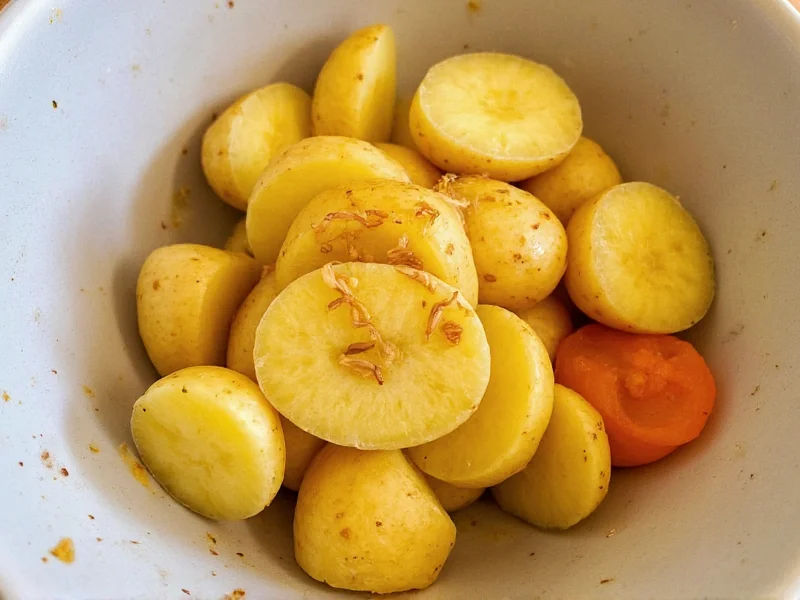Choosing the right potato variety can make or break your soup. Many home cooks discover too late that their carefully prepared soup has turned into a grainy, broken-textured disaster—all because of improper potato selection. Understanding the science behind potato starch content and cell structure helps you consistently create perfectly textured soups every time.
Why Potato Selection Matters for Soup Quality
Potatoes contain varying levels of starch and moisture that directly impact how they behave during cooking. When added to boiling liquid, potatoes undergo gelatinization—a process where starch granules absorb water and swell. The amount of swelling determines whether your potatoes hold their shape or disintegrate completely. This transformation affects not just the potato pieces themselves, but the entire soup's texture and mouthfeel.
Best Potato Varieties for Soup Applications
Not all potatoes perform equally in soup applications. The key differentiator is starch content, which falls into three main categories:
| Potato Type | Starch Content | Best Soup Applications | Texture Result |
|---|---|---|---|
| Yukon Gold | Medium (15-18%) | Creamy soups, chowders, vegetable soups | Creamy yet holds shape |
| Red Potatoes | Medium-low (14-16%) | Hearty vegetable soups, stews, minestrone | Firm chunks with slight creaminess |
| Fingerling | Medium-low (13-15%) | Elegant soups, gourmet presentations | Distinctive shape retention |
| Russet | High (20-22%) | Creamy pureed soups, bisques | Complete disintegration for thickening |
| Blue/Purple | Medium (16-18%) | Specialty soups, vibrant presentations | Color retention with firm texture |
Waxy Potatoes: The Soup Specialist
Waxy potatoes like Yukon Gold and red potatoes contain less starch and more moisture than their starchy counterparts. This composition creates a gelatinization temperature that's higher than typical soup cooking temperatures, allowing them to maintain structural integrity. When properly cooked, these varieties deliver a satisfying bite while releasing just enough starch to naturally thicken the surrounding broth.
Professional chefs consistently reach for Yukon Golds when preparing soups requiring distinct potato pieces. Their thin skin rarely needs peeling, their golden flesh adds visual appeal, and their naturally buttery flavor enhances soup profiles without overpowering other ingredients. For rustic vegetable soups, red potatoes provide excellent shape retention while contributing subtle earthiness.
When to Avoid Russet Potatoes in Soup
Russet potatoes, while excellent for baking and frying, often disappoint in chunky soups. Their high starch content (20-22%) causes rapid disintegration when boiled, resulting in cloudy broth and inconsistent texture. As russets break down, they release excessive free starch that creates a grainy mouthfeel rather than the smooth creaminess achieved through proper roux or béchamel techniques.
There are exceptions where russets shine: in pureed soups where complete breakdown is desired, or when making potato leek soup where texture uniformity is essential. Even then, many chefs prefer Yukon Golds for superior flavor and more predictable thickening properties.
Advanced Techniques for Perfect Potato Soup Texture
Even with proper potato selection, technique affects results. Cut potatoes to uniform 3/4-inch cubes to ensure even cooking. Add them to soup during the last 15-20 minutes of cooking to prevent over-softening. For acidic soups (like tomato-based varieties), add potatoes later in the cooking process since acid inhibits starch gelatinization.
Professional kitchens often par-cook potatoes separately before adding to soup. This technique provides precise control over potato texture and prevents starch migration into the broth. For cream-based soups, toss cut potatoes in a tablespoon of the recipe's fat (butter or oil) before adding to soup—this creates a protective coating that minimizes water absorption and maintains shape.
Troubleshooting Common Potato Soup Problems
Mushy potatoes: Usually caused by overcooking or using high-starch varieties. Solution: Reduce cooking time and switch to waxy potatoes. Add potatoes later in the cooking process.
Cloudy broth: Results from excessive starch release. Solution: Rinse cut potatoes before adding to soup, or use a potato variety with lower starch content.
Undercooked potatoes: Often happens when added to cold soup that's then brought to boil. Solution: Add potatoes to already simmering liquid, or cut smaller for faster cooking.
Bitter flavor: Can occur from using potatoes with green spots (solanine). Always inspect potatoes and remove any green areas before cooking.
Seasonal Considerations for Potato Selection
Potato quality varies throughout the year. Early summer brings new potatoes with exceptionally thin skins and delicate flavor—perfect for light spring soups. Fall harvest yields mature potatoes with thicker skins and higher starch content, better suited for hearty winter soups. Storage conditions significantly impact performance: potatoes kept below 45°F develop sweet flavors that can alter soup profiles, while those stored above 55°F sprout prematurely.
For optimal soup results, purchase potatoes that feel heavy for their size with smooth, unblemished skins. Avoid refrigeration, which converts starch to sugar. Store in a cool, dark place with good ventilation, preferably in a paper bag rather than plastic which traps moisture.











 浙公网安备
33010002000092号
浙公网安备
33010002000092号 浙B2-20120091-4
浙B2-20120091-4